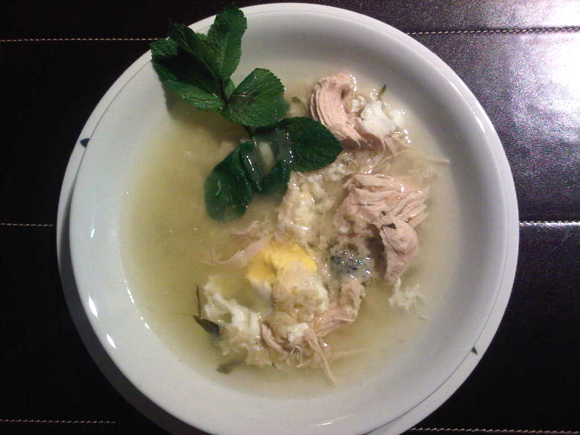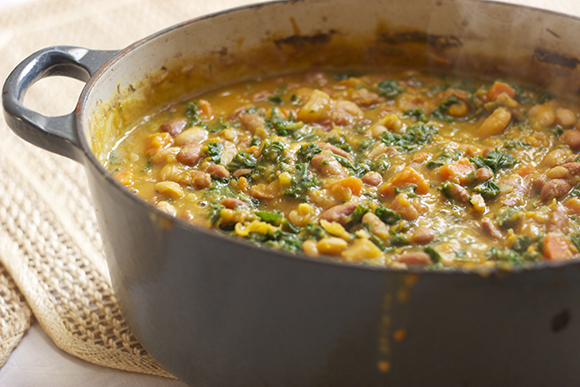A recipe for a typical Portuguese soup made by Sandra Moleirinho’s mother called ‘Canja de Galinha’ (Chicken Broth). The recipe below is her mother’s version, renamed ‘Canja da Zuzu.’ (Zuzu is her mother’s nickname). To follow, a fascinating history of this popular soup. Thank you to Sandra of Babajaan (and her Mother) for sharing this recipe, and the story behind it.
Canja da Zuzu
serves 4 people
4 Chicken fillets (without skin)
3 litres of water
Mint leaves
3 Shallots
1 cup of Wholegrain Basmati rice (well washed)
3 Eggs
Olive oil
Salt
Black pepper
Grated Parmesan
Add the water into a pan, together with the raw chicken breasts, peeled shallots, a little of olive oil, the mint, cook for 20 mins.
After 15min add the cup of wholegrain Basmati Rice and leave it for approx 15 mins.
Add the eggs and don’t mix it for 3 to 4 minutes, after that you can mix everything gently.
Take out the Chicken breasts, leave on a plate and leave everything else simmering.
Shred the Chicken and add it again to the mix.
Add Salt and pepper. Serve hot with grated Parmesan.
The journey of ‘Canja de Galinha’ from Portugal to Brazil
D. Pedro II (1825-1891), the emperor of Brazil was fascinated by this Asian plate. The Soup has gone down in history. Though facing competition from soups with a French accent, it has won fame as ‘hospital food’ and still attracts a legion of fans who seem to feel the same fascination for the recipe that D. Pedro II did all those years ago. Historians of the time observe that the monarch was determined to ‘enjoy a hot soup between the second and third acts of Theatre, which only began, therefore, to be given notice that His Majesty the ceiazinha ended.’ In history books, there is an interesting quote coming from the palace of Ajuda in Portugal: ‘The kitchen should always have fresh soup prepared for Queen Dona Maria Pia, which was consumed every day.’ Apparently, the invigorating recipe was almost a consensus among the Orleans e Bragança.
Stopover in Portugal
The soup arrived in Brazil after making a stop in Portugal. Of Asian origin, the dish was probably released by the court physician and naturalist Portuguese Garcia da Orta (1490-1570), who, after a trip to India, wrote of Colloquia and Simple Things Medicinal Drugs and India in 1563 , where he mentioned a certain ‘rice broth, or Canje.’
In the State of Malabar, in south-western coast of India, when it was the Portuguese colony of Goa, kanji written with ‘k’, was very common. The mixture of water and rice from India may have given birth to this delicious tradition, and the Portuguese added further to the dish with the combination of Chicken, spices and vegetables. Upon arriving in Brazil, 500 years ago, the Royal Family brought the recipe with them. Because it is so easy to do, people fell in love with it and several popular variations have been born.
In People’s mouth
s
Antonio Augusto de Oliveira, who along with partner Jose Cerqueira, has commanded the Eden Bar for four decades. Based in the hall of one of the oldest restaurants in Campinas, they make chicken soup for about 80 people per night, when the low temperature cools.
In command of the kitchen, Chef Severino Vicente de Brito, who has worked for 22 years at the site, says: ‘The common people like it. Every time you prepare the recipe, leave in your pot at least 50 servings. Sometimes you need to do more because it goes quickly.
The products used to make the soup must have quality in the first place. Then, (it) must be made with care.’
Got a cold? Run to the kitchen
Recently, an American researcher at the University of Nebraska named Stephen Rennard rehabilitated the dish to the post of ‘medicine.’ At least for colds.
According to their studies, chicken broth and vegetables such as onions, carrots and potatoes, have the power to slow the movement of neutrophils, ie. white blood cells (leukocytes) that while attacking the invading germs, are also responsible for much of the cold symptoms. He also demonstrated that the cysteine, an amino acid that releases the chicken during cooking, is chemically very similar to acetylcysteine, a drug commonly prescribed in cases of bronchitis. Therefore, when the nose starts to leak, run to the kitchen and make this soup!








This soup (Ganja da Zuzu) is delicious and is an excellent combination for the winter.
I suggest as an accompaniment to bread.
Congratulations to Sandra and Zuzu